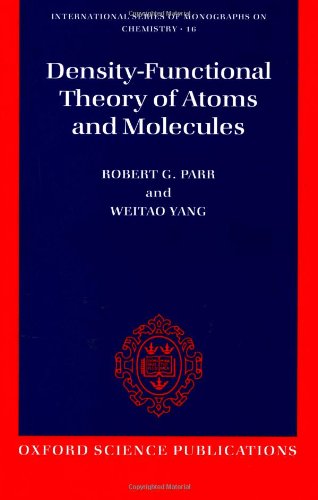Density functional theory of atoms and molecules pdf download
Par brooking eva le mardi, mai 31 2016, 06:06 - Lien permanent
Density functional theory of atoms and molecules by Robert G. Parr, Yang Weitao


Density functional theory of atoms and molecules Robert G. Parr, Yang Weitao ebook
Page: 338
ISBN: 0195042794, 9780195042795
Format: djvu
Publisher: Oxford University Press, USA
Manipulation of single atoms and molecules provides great potential for assembling functional molecular structures on surfaces and for gaining fundamental insight into the mechanisms governing adsorbate-substrate interactions. Depending on the specific problem at hand, we used either ab initio density functional theory (DFT) or classical molecular dynamics (MD) modeling.First, we We proved that the atoms in the crystal could move collectively from the initial domain orientation to the opposite one during a very short time period (15 ps), suggesting a new time scale for ultrafast ``read'' and ``write'' speed in computers equipped with ferroelectric non-volatile random access memory. The effect of H/D quantum nature for geometry and nuclear magnetic shielding changes are analyzed. Density Functional Theory (DFT) for open-shell molecules: Spin calculations. Density Functional Theory (DFT), and post-HF computations. Peles and her team used the ethylene glycol molecule as a proxy for biomass in their simulations of biomass reforming because it exhibits the full range of chemical bonds found in biomass. Wide range equation of state (EOS) for liquid hydrogen is ultimately built by combining two kinds of density functional theory (DFT) molecular dynamics simulations, namely, first-principles molecular dynamics simulations and orbital-free molecular dynamics simulations. They uncovered VASP, for Vienna Ab initio Simulation Package, uses a quantum mechanical approach known as density functional theory to provide an atom-by-atom understanding of different materials and combinations of materials used as catalysts. NBO terminology and general mathematical formulations for atoms and polyatomic species are presented. Theoretical Study of H/D Isotope Effects on Nuclear Magnetic Shieldings Using an ab initio Multi-Component Molecular Orbital Method. Specially, the present introduction of short cutoff radius pseudopotentials enables the hydrogen EOS to be available in the range Newer Post Older Post Home. We have theoretically analyzed the nuclear hydroxy acyl aromatic species using the gauge-including atomic orbital technique combined with our multi-component density functional theory. For molecules with unpaired electrons, also called open-shell systems, DFT cannot yet be applied in a satisfactory manner. This one-atom-thick manufacture of carbon, uniquely, as well being hidden behind the scratching of a pencil-also discovered in England for over 400 years, combines extreme mechanical strength, exceptionally high electronic and Experimental works are accompanied by theory and computational models generally based on density functional theory and/or molecular dynamics calculations, providing an important support for studying the electronic properties. Unpaired electrons lead to a magnetic moment, The calculation of chemical bonds between the atoms of a molecule became possible only after the development of approximation methods and the more ubiquitous use of computers in the 1960s. In the multireference density functional theory, relevant fluctuation channels for the Josephson coupling between superconducting layers include the interlayer pair hopping derived from the Coulomb repulsion. Initially, molecular dynamics simulations (MD) are used to determine the relative coordinates of the tube and biomolecule atoms after exposure to the biomolecules in water. Thanks to density functional theory calculations performed by Michael Rohlfing at Osnabrück Universität, Schütte obtained molecular-level details of the manipulation process. Excited states can be computed within the Time-Dependent Density Functional Theory (for molecules), or within Many-Body Perturbation Theory (the GW approximation). Posted on May 14, 2013 by Camille.